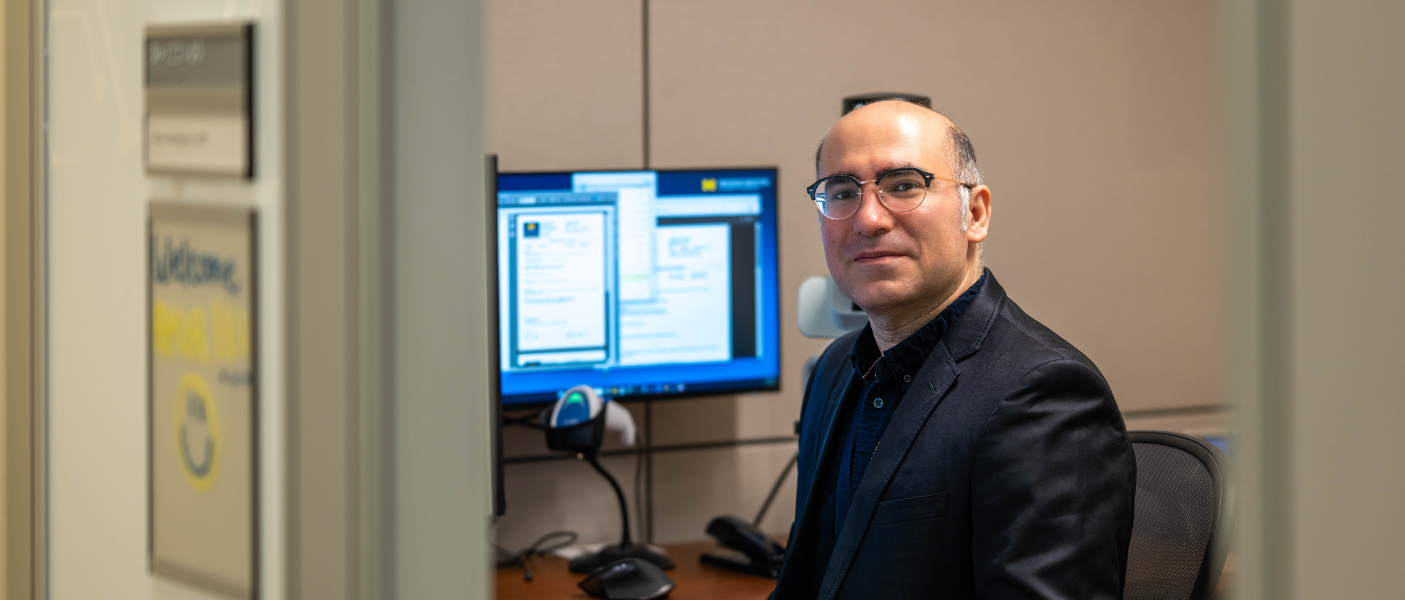

When a seven-year-old boy left his rural village to live with an aunt in the city, he could not have known that this moment would one day shape the life of his future son. Uprooted from his parents and siblings, he began a new chapter in an unfamiliar place. This pivotal change marked the beginning of a multi-generational story, now bearing fruit in its third act. That boy would go on to become a revered mathematics teacher in Esfahan, Iran. He married a fellow educator, and together they had a son: Amir.
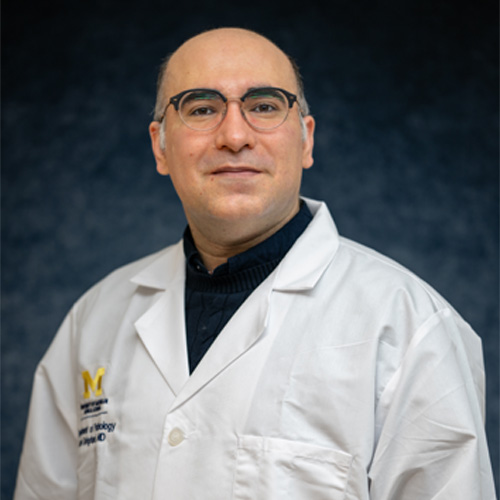 “My father always told me, ‘You should strive for the best. Aim for the highest goal and work tirelessly for it. You may or may not achieve it, but if you don’t aim for it, you certainly never will,’” recalls Dr. Amir Dehghani, clinical assistant professor of pathology. For Dehghani, dedicating himself to the service of humanity by alleviating pain and suffering through the field of medicine was the most meaningful aspiration he could pursue.
“My father always told me, ‘You should strive for the best. Aim for the highest goal and work tirelessly for it. You may or may not achieve it, but if you don’t aim for it, you certainly never will,’” recalls Dr. Amir Dehghani, clinical assistant professor of pathology. For Dehghani, dedicating himself to the service of humanity by alleviating pain and suffering through the field of medicine was the most meaningful aspiration he could pursue.
“In Iran, gaining admission to medical school is an intensely competitive process,” he explained. “Each year, about 500,000 candidates take the entrance exam for only 1,000 available seats. I completed the academic coursework for four years of high school in just two and then dedicated the following last two years of high school solely to preparing for this life-defining exam.”
Dehghani succeeded in securing a place at one of Iran’s most prestigious medical schools, the Isfahan University of Medical Sciences, where he earned his medical degree. From the outset, his ambition was clear: to serve the community by reducing the burden of physical and mental illness. “I wanted to care for patients and alleviate their suffering. While most pathologists don’t interact with patients directly, as a cytopathologist I do. I perform fine-needle aspirations to diagnose cancers. This kind of direct patient involvement is profoundly rewarding.”
His decision to pursue pathology came early in his medical education. Drawn equally to the foundational sciences, medical research, and emerging technologies, as well as to hands-on patient care, he saw pathology as the ideal confluence of both worlds—a discipline that could offer both intellectual rigor and clinical impact.
After graduating from medical school, Dehghani practiced as a general physician in both urban and rural settings in Iran. During that time, he recognized how often he relied on pathologists, the "doctor’s doctor", to help diagnose and manage complex cases. This realization solidified his commitment to pursuing pathology.
In 2015, his wife, a chemical engineer, was accepted into a Ph.D. program at the University of Louisville. The couple relocated to the United States. “I initially arrived on a B2 visa to sit for the USMLE exams, later converting to an F2 visa as my wife’s dependent. It was an extremely challenging period—I wasn’t allowed to work or even sometimes to volunteer.”
Despite these limitations, Dehghani carved out opportunities for growth. He completed observerships in pathology at the University of Indiana and Kings County Hospital in New York. After passing all steps of the USMLE, he was accepted into the pathology residency program at the State University of New York Downstate Health Sciences University, where he ultimately served as chief resident.
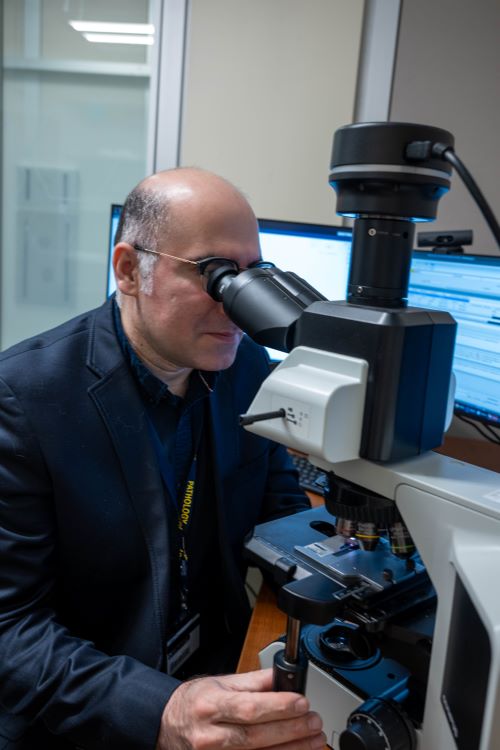 His initial exposure to cytology during residency was daunting. “I remember thinking, ‘How can someone diagnose cancer just by looking at a few cells?’” He recalls one of his mentors, Dr. Anthony Nicastri, examining a scant sample and stating confidently, “This is a clear cell renal cell carcinoma.” Subsequent imaging revealed a mass in the kidney, later confirmed on resection. “That moment was transformative for me. I realized cytopathology was a real challenge, and I thrive on challenges. Over time, it became my passion.”
His initial exposure to cytology during residency was daunting. “I remember thinking, ‘How can someone diagnose cancer just by looking at a few cells?’” He recalls one of his mentors, Dr. Anthony Nicastri, examining a scant sample and stating confidently, “This is a clear cell renal cell carcinoma.” Subsequent imaging revealed a mass in the kidney, later confirmed on resection. “That moment was transformative for me. I realized cytopathology was a real challenge, and I thrive on challenges. Over time, it became my passion.”
He pursued a cytopathology fellowship at Memorial Sloan Kettering Cancer Center, one of the earliest institutions to adopt digital pathology. There, he performed up to 17 FNAs per day and honed his diagnostic skills by correlating cytologic findings with surgical pathology results.
During his residency, Dehghani became increasingly aware of the systemic health disparities facing underserved communities. “Many of our patients came in far too late, presenting with advanced disease. I realized the critical role a gynecologic pathologist can play, not just in diagnosis, but in addressing health inequities through research.” This growing interest led him to complete a women’s and perinatal pathology fellowship at Brigham and Women’s Hospital at Harvard Medical School, where he trained under Drs. Christopher Crum, Marisa Nucci, and George Mutter—world leaders and textbook authors in the field.
“It was an extraordinary privilege to be mentored by individuals who are not only pioneers in their disciplines but also redefining diagnostic criteria and writing the definitive literature. That kind of immersive, world-class training shaped my clinical and academic perspective deeply.”
During his final year of training, Dehghani’s wife was based in New Jersey, and the couple endured long stretches apart throughout their educational pursuits. After completing his fellowships, Dehghani returned to New York, where he held a faculty position as a clinical assistant professor of pathology. Though the role was fulfilling, he longed for a more rigorous academic environment where he could push the boundaries of research and education in his field.
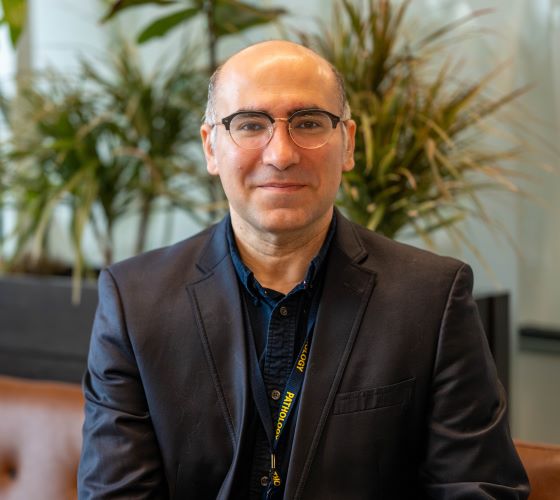 When he saw an opening at Michigan Medicine, he knew it was the right next step. “The University of Michigan has one of the most prestigious pathology departments in the country, with one of the most complex and challenging caseloads. I had met Dr. Kathleen Cho and Dr. Stephanie Skala at USCAP. They are not only brilliant pathologists but also wonderful individuals. I was also drawn to Dr. David Chapel, who I believe is a rising star in gynecologic pathology. My father always encouraged me to reach for the best—and Michigan was the best.”
When he saw an opening at Michigan Medicine, he knew it was the right next step. “The University of Michigan has one of the most prestigious pathology departments in the country, with one of the most complex and challenging caseloads. I had met Dr. Kathleen Cho and Dr. Stephanie Skala at USCAP. They are not only brilliant pathologists but also wonderful individuals. I was also drawn to Dr. David Chapel, who I believe is a rising star in gynecologic pathology. My father always encouraged me to reach for the best—and Michigan was the best.”
In April 2025, Dehghani relocated to Michigan. Now, he is energized by the opportunity to engage with a dynamic and diverse case mix, conduct impactful research, and educate the next generation of physicians in gynecologic pathology and cytopathology. “Teaching is deeply personal for me. Both of my parents were teachers, and I see education as a legacy. I want to make the path easier for my trainees, to help them learn more effectively than I did. If I can contribute meaningfully to their growth, I’ll have done something worthwhile.”
Outside of medicine, Dehghani’s greatest joy lies in his family. “My wife, Marzi, and I have been together since I was 21. She has been my unwavering support, my partner through every chapter. I am incredibly blessed to share my life with her.” On March 6th, the couple welcomed their daughter, Dana, who has become the light of their lives. “Dana has brought a whole new dimension of joy to my world. Every moment with her is a reminder of what truly matters.”
Due to logistical challenges, Marzi and Dana have not yet been able to fully relocate to Michigan, though Dehghani or his wife visit each other frequently and look forward to the day they can reunite under one roof. In the meantime, he shares his home with two beloved cats, Silver and Sasha, who provide comfort and companionship.
In his free time, he enjoys long walks, jogging, and watching films. He’s also an enthusiast of automotive news and innovation. “Ann Arbor has been incredibly welcoming. It offers everything I need—culture, nature, museums, restaurants. It feels like a place where we could build a life together. When my wife and daughter can finally join me here, I hope this city becomes our forever home.”
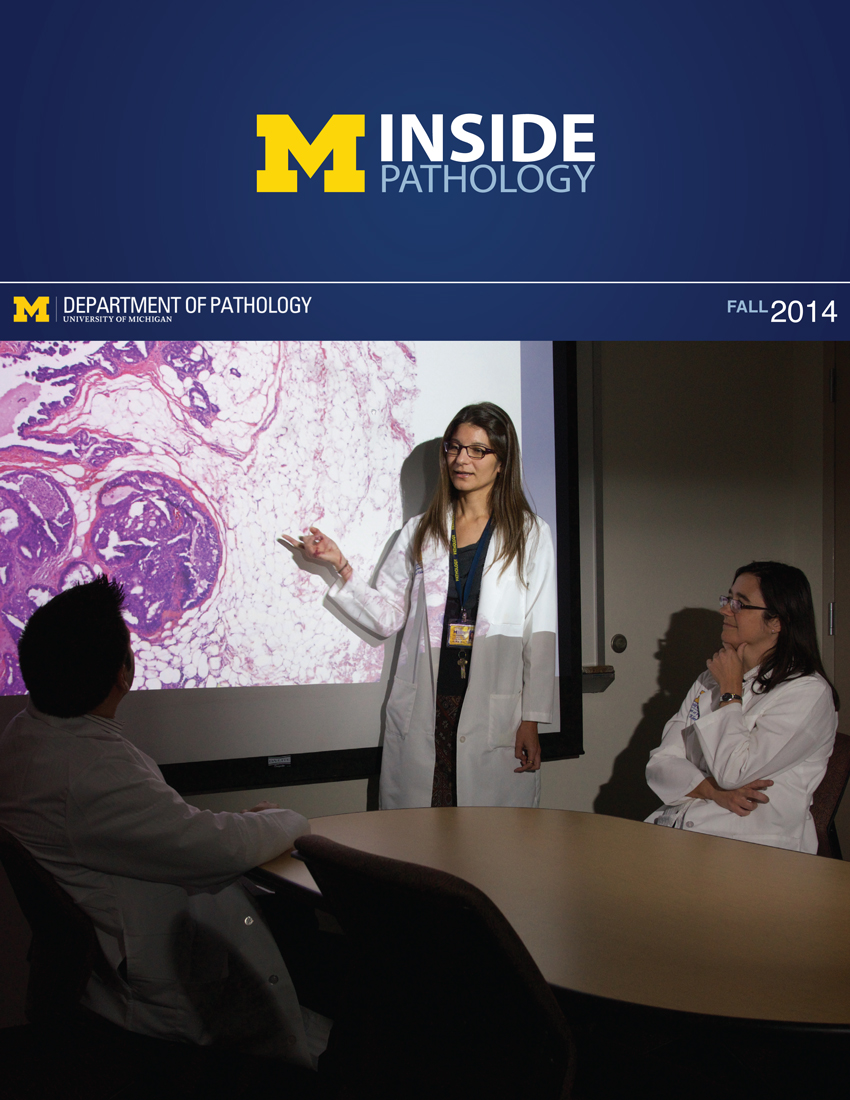 ON THE COVER
ON THE COVER
Breast team reviewing a patient's slide. (From left to right) Ghassan Allo, Fellow; Laura Walters, Clinical Lecturer; Celina Kleer, Professor. See Article 2014Department Chair |

newsletter
INSIDE PATHOLOGYAbout Our NewsletterInside Pathology is an newsletter published by the Chairman's Office to bring news and updates from inside the department's research and to become familiar with those leading it. It is our hope that those who read it will enjoy hearing about those new and familiar, and perhaps help in furthering our research. CONTENTS
|
 ON THE COVER
ON THE COVER
Autopsy Technician draws blood while working in the Wayne County morgue. See Article 2016Department Chair |

newsletter
INSIDE PATHOLOGYAbout Our NewsletterInside Pathology is an newsletter published by the Chairman's Office to bring news and updates from inside the department's research and to become familiar with those leading it. It is our hope that those who read it will enjoy hearing about those new and familiar, and perhaps help in furthering our research. CONTENTS
|
 ON THE COVER
ON THE COVER
Dr. Sriram Venneti, MD, PhD and Postdoctoral Fellow, Chan Chung, PhD investigate pediatric brain cancer. See Article 2017Department Chair |

newsletter
INSIDE PATHOLOGYAbout Our NewsletterInside Pathology is an newsletter published by the Chairman's Office to bring news and updates from inside the department's research and to become familiar with those leading it. It is our hope that those who read it will enjoy hearing about those new and familiar, and perhaps help in furthering our research. CONTENTS
|
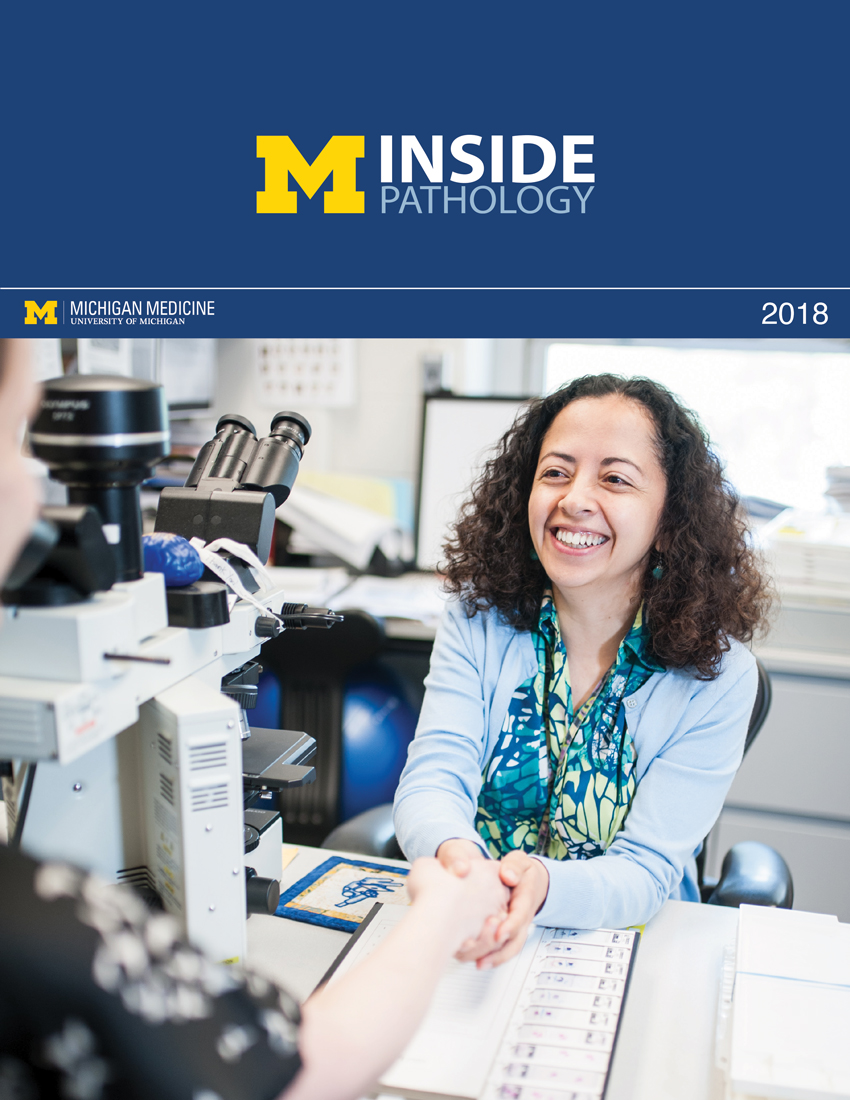 ON THE COVER
ON THE COVER
Director of the Neuropathology Fellowship, Dr. Sandra Camelo-Piragua serves on the Patient and Family Advisory Council. 2018Department Chair |

newsletter
INSIDE PATHOLOGYAbout Our NewsletterInside Pathology is an newsletter published by the Chairman's Office to bring news and updates from inside the department's research and to become familiar with those leading it. It is our hope that those who read it will enjoy hearing about those new and familiar, and perhaps help in furthering our research. CONTENTS
|
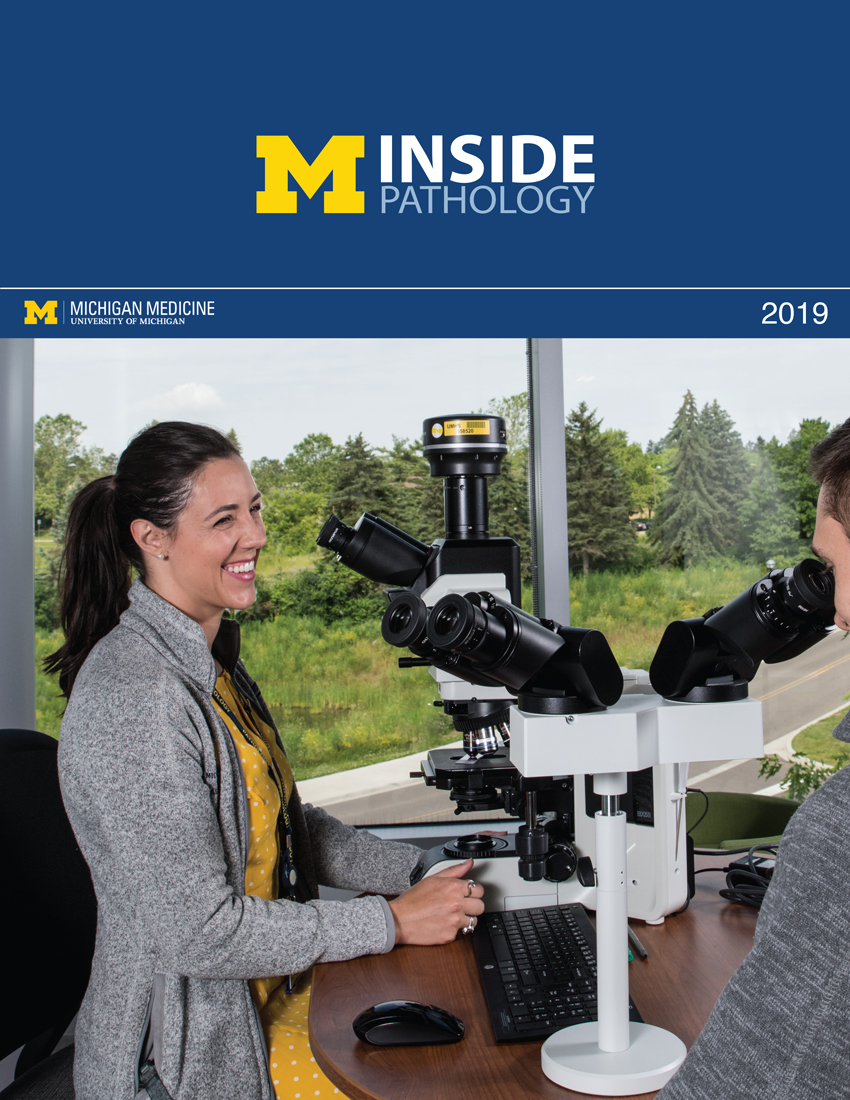 ON THE COVER
ON THE COVER
Residents Ashley Bradt (left) and William Perry work at a multi-headed scope in our new facility. 2019Department Chair |

newsletter
INSIDE PATHOLOGYAbout Our NewsletterInside Pathology is an newsletter published by the Chairman's Office to bring news and updates from inside the department's research and to become familiar with those leading it. It is our hope that those who read it will enjoy hearing about those new and familiar, and perhaps help in furthering our research. CONTENTS
|
 ON THE COVER
ON THE COVER
Dr. Kristine Konopka (right) instructing residents while using a multi-headed microscope. 2020Department Chair |

newsletter
INSIDE PATHOLOGYAbout Our NewsletterInside Pathology is an newsletter published by the Chairman's Office to bring news and updates from inside the department's research and to become familiar with those leading it. It is our hope that those who read it will enjoy hearing about those new and familiar, and perhaps help in furthering our research. CONTENTS
|
 ON THE COVER
ON THE COVER
Patient specimens poised for COVID-19 PCR testing. 2021Department Chair |

newsletter
INSIDE PATHOLOGYAbout Our NewsletterInside Pathology is an newsletter published by the Chairman's Office to bring news and updates from inside the department's research and to become familiar with those leading it. It is our hope that those who read it will enjoy hearing about those new and familiar, and perhaps help in furthering our research. CONTENTS
|
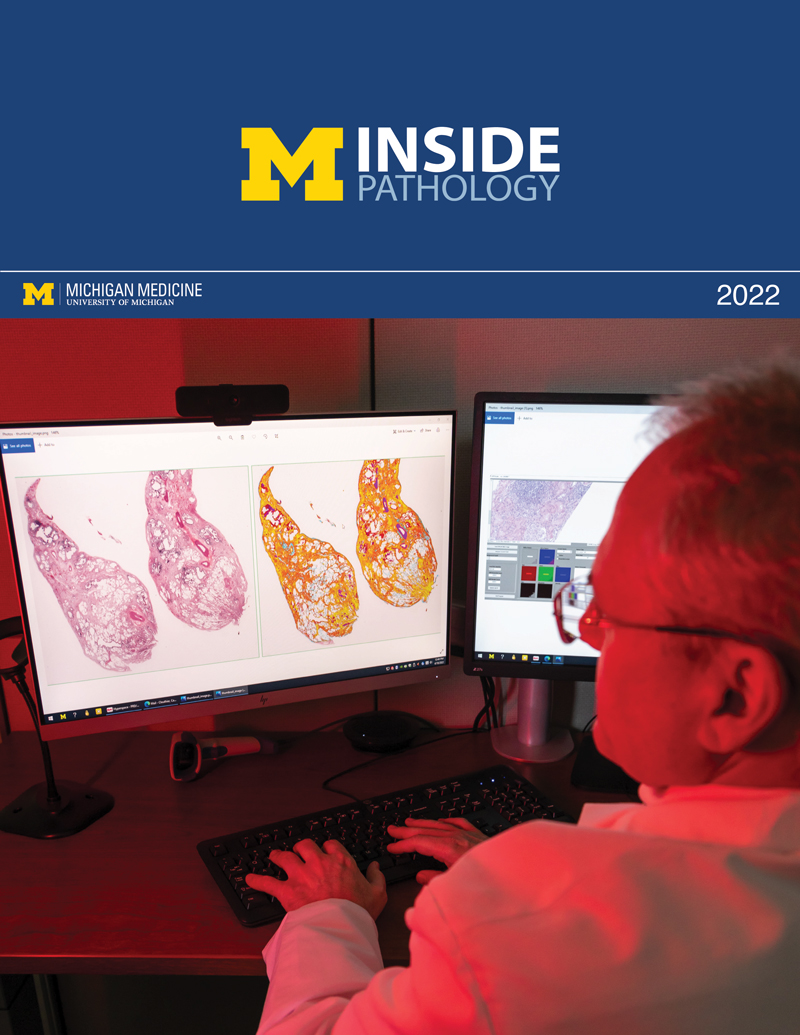 ON THE COVER
ON THE COVER
Dr. Pantanowitz demonstrates using machine learning in analyzing slides. 2022Department Chair |

newsletter
INSIDE PATHOLOGYAbout Our NewsletterInside Pathology is an newsletter published by the Chairman's Office to bring news and updates from inside the department's research and to become familiar with those leading it. It is our hope that those who read it will enjoy hearing about those new and familiar, and perhaps help in furthering our research. CONTENTS
|
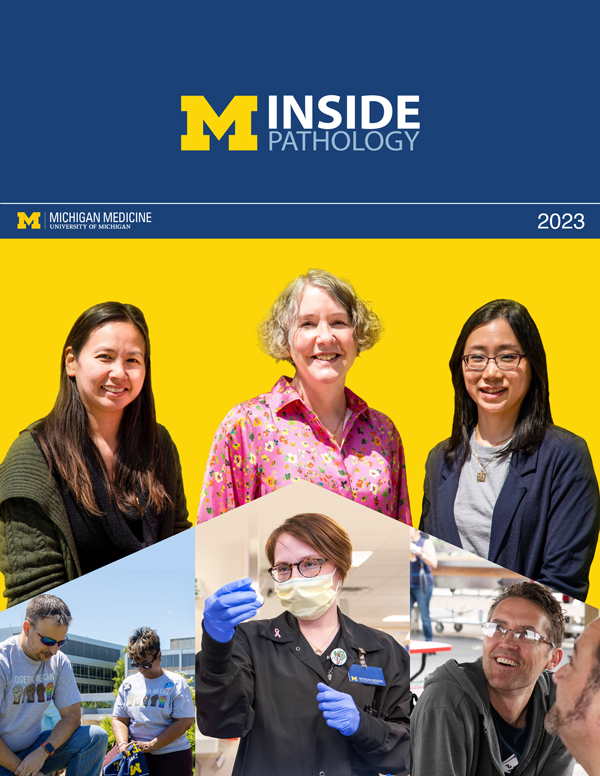 ON THE COVER
ON THE COVER
(Left to Right) Drs. Angela Wu, Laura Lamps, and Maria Westerhoff. 2023Department Chair |

newsletter
INSIDE PATHOLOGYAbout Our NewsletterInside Pathology is an newsletter published by the Chairman's Office to bring news and updates from inside the department's research and to become familiar with those leading it. It is our hope that those who read it will enjoy hearing about those new and familiar, and perhaps help in furthering our research. CONTENTS
|
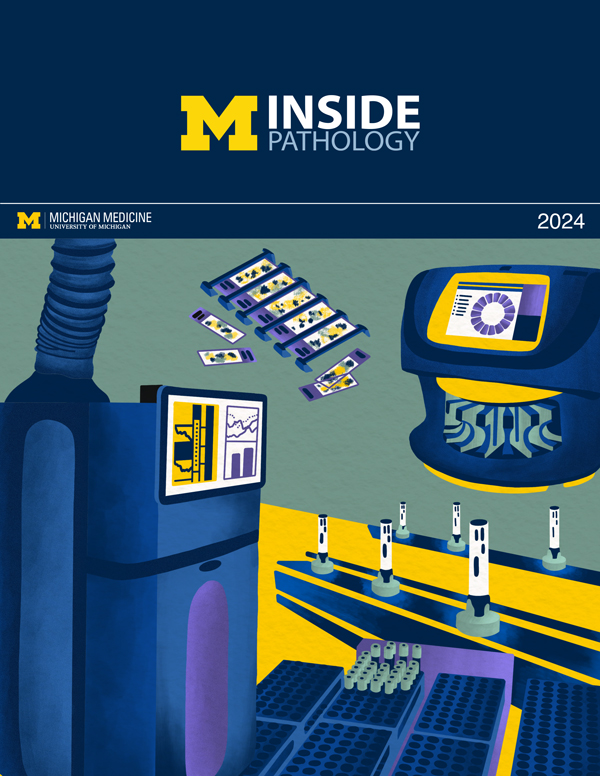 ON THE COVER
ON THE COVER
Illustration representing the various machines and processing used within our labs. 2024Department Chair |

newsletter
INSIDE PATHOLOGYAbout Our NewsletterInside Pathology is an newsletter published by the Chairman's Office to bring news and updates from inside the department's research and to become familiar with those leading it. It is our hope that those who read it will enjoy hearing about those new and familiar, and perhaps help in furthering our research. CONTENTS
|
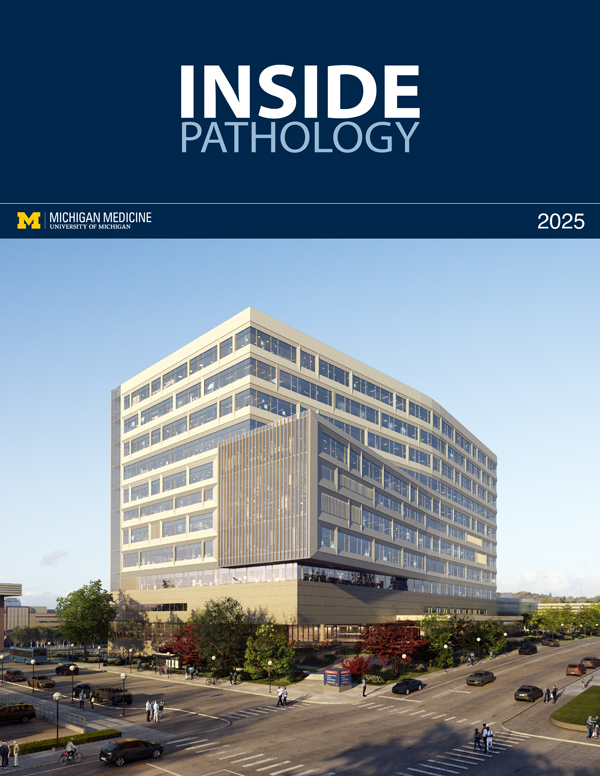 ON THE COVER
ON THE COVER
Rendering of the D. Dan and Betty Khn Health Care Pavilion. Credit: HOK 2025Department Chair |

newsletter
INSIDE PATHOLOGYAbout Our NewsletterInside Pathology is an newsletter published by the Chairman's Office to bring news and updates from inside the department's research and to become familiar with those leading it. It is our hope that those who read it will enjoy hearing about those new and familiar, and perhaps help in furthering our research. CONTENTS
|

MLabs, established in 1985, functions as a portal to provide pathologists, hospitals. and other reference laboratories access to the faculty, staff and laboratories of the University of Michigan Health System’s Department of Pathology. MLabs is a recognized leader for advanced molecular diagnostic testing, helpful consultants and exceptional customer service.